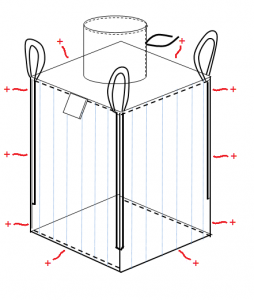A flexible intermediate bulk container (FIBC), bulk bag, or big bag, is an industrial container made of flexible fabric that is designed for storing and transporting dry, flowable products, such as sand, fertilizer, and granules of plastic.

Type A FIBC bags
Type A bags don’t usually carry identification tags on them. They do not have any mechanism for dissipating static electricity, so it is essential that they are not used to store or transport combustible materials or used in flammable or combustible atmospheres.
Type B FIBC bags
Type B bags are made from materials that have a low breakdown voltage which help prevent the occurrence of propagating brush discharges. They do not have any mechanism for dissipating static electricity. All Conductive Objects within a 1 meter area surrounding Type B bags (in use) must be earthed to prevent inductive charging of isolated conductors.
Type C FIBC bags
Type C bags are designed to dissipate static electricity through static dissipative or conductive threads that are interwoven through the bag’s material. They must be earthed.
Type D FIBC bags
Type D bags are made from static protective fabric designed to prevent the occurrence of incendiary sparks, brush discharges and propagating brush discharges, without the need for a connection from the FIBC to earth. All Conductive Objects within a 1 meter area surrounding Type D bags (in use) must be earthed to prevent inductive charging of isolated conductors.
Type B, C and D FIBC bags will carry yellow identification tags if they are IEC certified. These tags will specify the bag type along with any other relevant information for that specific bag type.
One example of identification tag on the FIBC Type C bags:

Type C FIBC bags are the only type of FIBC that can (and must) be earthed.
Adding an earthing clamp to a big bag that is not a Type C can cause a spark to happen and is therefore dangerous to use.
Keep up good work.
Arpad
exprofessional.com





